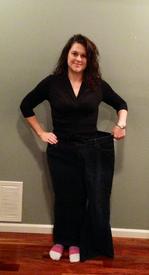How accurate are HRM

Rebecca_MT
Posts: 25 Member
I currently have the Polar FT4 and used it for the first time during my 30 day shred workout dvd. I clearly programed my correct weight (116) and height but was wondering how accurate the calorie burn would be. I worked out for 25 minutes and it claims I burned 203 calories. Does this sound accurate? What is your take on the calories burned?
0
Replies
-
It will be most accurate for steady state cardio, such as running. For 30 day shred, it's probably fairly accurate. I think around 200 calories would be right for me, but I'm much heavier than you. I'd probably reduce those calories if you're only 116 lbs. Of course, I'm also old, so if you're young, that might negate the lower weight.0
-
it's all an estimate, but it's going to be more accurate for steady state aerobic acitvity like running or cycling as the algorithms used assume that kind of activity...but even still, it's an estimate...i'd still knock off about 20% for an aerobic activity...the further away you get from that type of activity, the less accurate it will be for calories burned.0
-
Yea 200 is a pretty good ballpark number for a 25 minute workout. To be safe only eat back like 50-60% of the cals burned until you get a good gauge of your weight loss. If the weight starts coming off to fast then you can start eating back more. And vice versa.0
-
Thank you all! I wont take the calorie burn that literal0
-
This MFP blog post from five years ago is still pretty much spot on. Unless you have a high-end HRM that uses Firstbeat's technology to analyze the gaps between individual heartbeats, the equations that they use are accurate only for steady-state cardio, and even there, there's a substantial amount of variance that heart rate, weight, gender, and age don't account for.
You can use your HRM to get a ballpark estimate, especially if your activity level is fairly constant, but keep in mind that it's only an estimate, and that you should compare results against your estimates to see how useful it really is.0 -
Thank you for the article! It is really helpful
 0
0 -
Why are the algorithms so different when I use my Digifit app and the Polar app? An hour of cardio on Digifit is over 1100 cal and a similar hour using Polar is only around 500. I put the same metrics in (weight, height) and I’m using the same chest strap so the difference has to be in their algorithms. When I’m on the stationary bike or the AMT the machine’s HR monitor when you hold the handles says almost the same as either app so it has to be how they figure out calories burned.
How do I find out which is most accurate representation of my calories burned?0 -
This MFP blog post from five years ago is still pretty much spot on. Unless you have a high-end HRM that uses Firstbeat's technology to analyze the gaps between individual heartbeats, the equations that they use are accurate only for steady-state cardio, and even there, there's a substantial amount of variance that heart rate, weight, gender, and age don't account for.
You can use your HRM to get a ballpark estimate, especially if your activity level is fairly constant, but keep in mind that it's only an estimate, and that you should compare results against your estimates to see how useful it really is.
I have a Garmin 910XT that uses the Firstbeat technology, and at least for running, I haven't found it to be any better than my Polar FT40 for calculating calories. The calculated calorie counts are HIGHLY dependent on weather and conditions, and if anything, my Garmin feels like it varies more. I ran the same course when it was 80 and sunny, vs. 70 and overcast, and my calorie counts varied by 25-30%.0 -
HRMs are for tracking steady state cardio only. It is important to note that HRMs are not accurate for weight lifting and will not give you an accurate burn. They are also not meant for HIIT. Temperature extremes and daily burn tracking (e.g. I wear it all day to find out what I should be taking in) are also inaccurate. HRMs are for steady state aerobic exercise only!
This is a helpful blog post for understanding HRMs:
http://www.myfitnesspal.com/blog/Azdak/view/the-real-facts-about-hrms-and-calories-what-you-need-to-know-before-purchasing-an-hrm-or-using-one-21472
HRMs are not 100% accurate even when they are used for their intended purpose (steady state cardio). They still have a margin of error. That being said, when HRMs are used for purposes they are not intended for they can become grossly inaccurate. It really isn't much better than pulling a number out of nowhere if the device is being used for things it was never designed to handle.
I personally have both a Bodymedia Fit (for daily activity tracking) and a HRM (for my steady state cardio). I love them both! However, it is important to know what these devices are actually designed to track. They are very helpful when they are used correctly! 0
0 -
You can test how heart rate affects your GPS/running watch's calorie calculation.
Run with the chest strap on;
Run same course with the chest strap off.
Compare.
0
This discussion has been closed.
Categories
- All Categories
- 1.4M Health, Wellness and Goals
- 398.5K Introduce Yourself
- 44.7K Getting Started
- 261K Health and Weight Loss
- 176.4K Food and Nutrition
- 47.7K Recipes
- 233K Fitness and Exercise
- 462 Sleep, Mindfulness and Overall Wellness
- 6.5K Goal: Maintaining Weight
- 8.7K Goal: Gaining Weight and Body Building
- 153.5K Motivation and Support
- 8.4K Challenges
- 1.4K Debate Club
- 96.5K Chit-Chat
- 2.6K Fun and Games
- 4.8K MyFitnessPal Information
- 18 News and Announcements
- 21 MyFitnessPal Academy
- 1.5K Feature Suggestions and Ideas
- 3.2K MyFitnessPal Tech Support Questions







